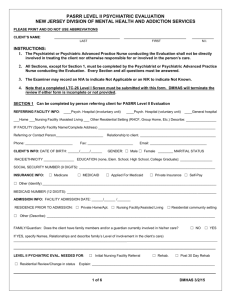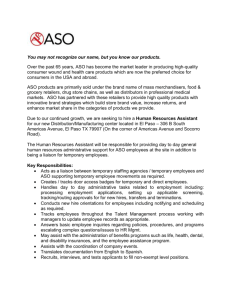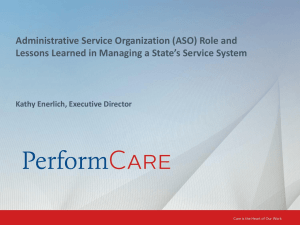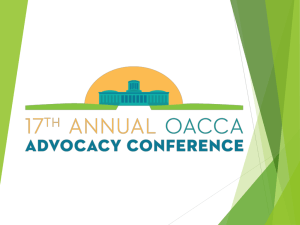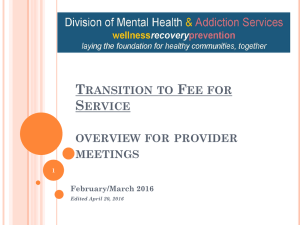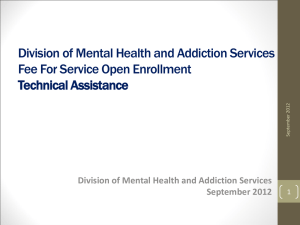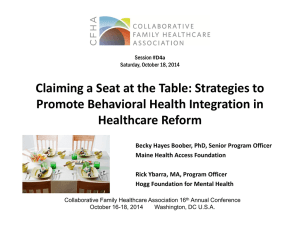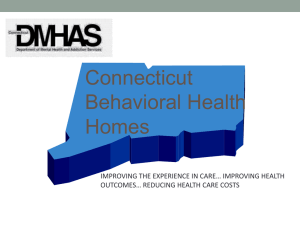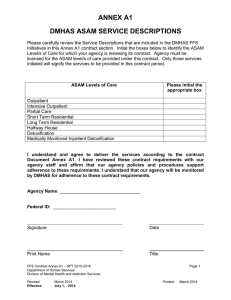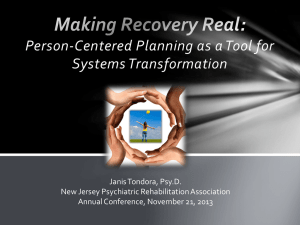DMHAS Transformation - State of New Jersey
advertisement
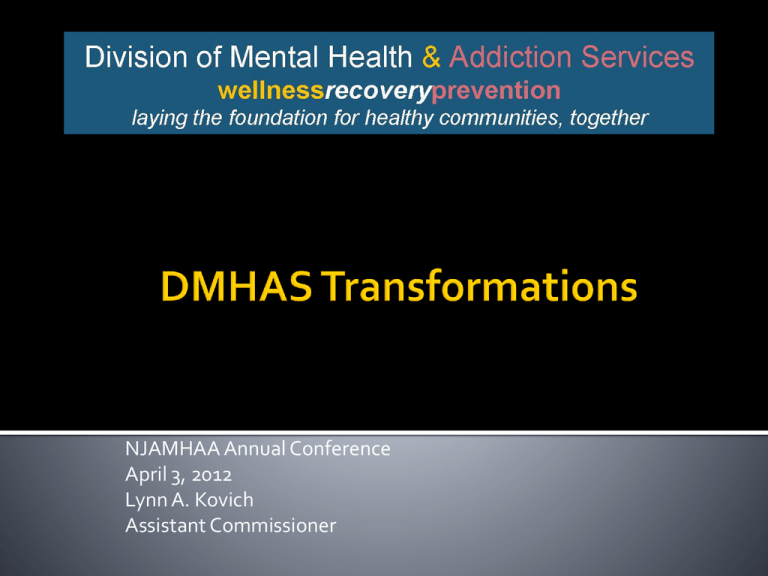
NJAMHAA Annual Conference April 3, 2012 Lynn A. Kovich Assistant Commissioner DMHAS is undertaking multiple, simultaneous advances: The goal is to build a continuum of services that will meet the holistic needs of our consumers We are striving to create a system where consumers can find the services they need from a single point of entry. 2 The Merger Hagedorn Closing Medicaid Waiver-ASO/MBHO Transitioning Adolescent Substance Abuse Services to DCF Governor's Proposed Drug Court Expansion 3 New table of organization since December 2011 Efforts underway to co-locate the offices Began cross-training our staff Reviewing/developing merged policies and practices Implementing various co-occurring initiatives 4 Hospital will be closed by June 30, 2012 Hagedorn Stakeholder Group has been meeting monthly to review the steps taken by the division to discharge patients, provide guidance to employees, and power down the hospital Statistics on the closing can be found on the DHS website under Hagedorn closure. 5 The Waiver was submitted last September. It is a collection of reform initiatives designed to: sustain the program long-term as a safety-net for eligible populations rebalance resources to reflect the changing healthcare landscape prepare the State to implement provisions of the federal Affordable Care Act in 2014 DMHAS and Medicaid will procure the services of an Administrative Services Organization (ASO) and subsequent at-risk Managed Behavioral Health Organization (MBHO) to be supported by FFP and State match starting in FY 2014. 6 Implementation of the ASO provides opportunities for increased FFP within the behavioral health system of care by increasing the range of program services and rebalancing fair market rates for Medicaid and statefunded programs. The ASO also will allow DMHAS to transition from a cost reimbursement to a fee-for-service contracting method. This advance will include a braiding of federal block grant and state dollars with Medicaid resources to support a comprehensive array of treatment and recovery support services for qualified program participants 7 Provides increased focus on populations with specific needs, including SAI (Welfare to Work), Medication Assisted Treatment Initiative (MATI), and consumers with intellectual and developmental disabilities Represents a shift away from institutional care towards community-based care, with an emphasis on wellness and recovery. Includes the integration of mental health and addiction services and behavioral health and primary care services through screening, intervention, and referral in both systems as well as the creation of behavioral health homes 8 This initiative, once implemented, will improve access, quality, and value within the state’s behavioral health system of care DMHAS and Medicaid have partnered to design, procure, and implement the ASO/MBHO according to the following timeline: July 2012 – ASO/MBHO RFP Posted January 2013 – RFP Awarded January –April 2013- ASO/MBHO Readiness Review July 2013 – ASO/MBHO implementation 9 DMHAS and DMAHS formed a Steering Committee to elicit broad stakeholder input. The Steering Committee initiated a workgroup process to inform recommendations at a more detailed level with a focus on clinical practice, access, financing, and performance standards. The workgroups met during February and March 2012. Final recommendations to DHS are expected in April 2012. 10 DCF’s System of Care will provide a single point of entry to a broad array of services. Adolescents with substance abuse disorders will be transitioned into the service delivery system of care within the DCF, Division of Child Behavioral Health Services (DCBHS) in January 2013. All services for youth with intellectual and developmental disabilities also will be integrated into the DCBHS System of Care. 11 Integration was recommended by the Adolescent Substance Abuse Task Force formed in July 2009 and part of a work plan developed in September 2011 by a joint workgroup from DHS/DMHAS and DCBHS. We know that a single point of entry to integrated care will help families access the behavioral health and substance abuse services their children need. This transition recognizes that adolescents with cooccurring mental health and substance use disorders also may experience behavioral problems, skill deficits, academic difficulties and family issues. 12 Transitioning adolescent addiction services to DCBHS will offer quicker access to a broad array of services and resources and will recognize the importance of the whole family in achieving wellness. Integration also has the potential to allow the State to leverage federal Medicaid funds and maximize the service options available for youth with substance abuse problems. 13 DMHAS convened a large stakeholder group on March 13, 2012 to discuss the strengths and challenges of the current system to ensure open deliberation of the process. An internal DMHAS and DCBHS workgroup also meets regularly to focus on: clinical screening/assessment tools clinical continuing stay reviews clinical services array evidence based practice access points income eligibility Rate setting 14 A smaller advisory group also was convened to assist in moving the transition forward. This advisory group will meet monthly through January 2013. Specifically, the advisory group will identify the guiding principles for the transition, discuss fiscal concerns, consider any impact to the counties, and determine what agencies need to do to prepare for the transition. The transition goal is to develop an integrated system that will provide the opportunity to coordinate services in an innovative way that will result in increased efficiency and improved outcomes for children. 15 The purpose of this transition is to keep children: at home in school in the community focused on recovery 16 Governor Christie included in his FY 2013 Budget Address a plan to expand Drug Court to ensure non-violent offenders get addiction treatment. The proposed budget would provide and initial appropriation of $2.5 million for expansion. DMHAS will work collaboratively with the Department of Law and Public Safety and the Governor’s Office to develop this initiative. 17 This Administration has made a commitment to fund services for individuals with mental illness and addiction disorders. The Governor’s proposed FY’ 13 budget includes: Mental health community growth of $13.683M Substance abuse community growth of $2.022M 18 The Department will be testifying on Wednesday, April 4 before the Assembly Budget Committee at 10 a.m. to report on current programs and services and then at 3 p.m. with DCA, DCF and DHSS regarding the restructuring of services as proposed in the FY’13 budget. 19
